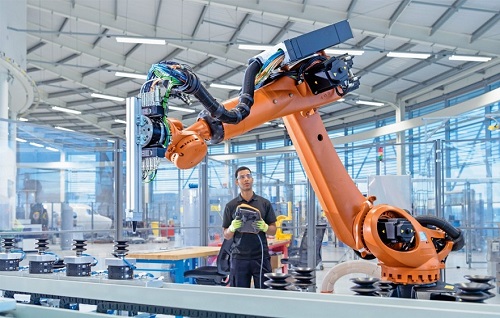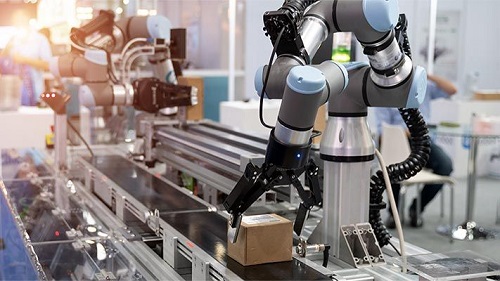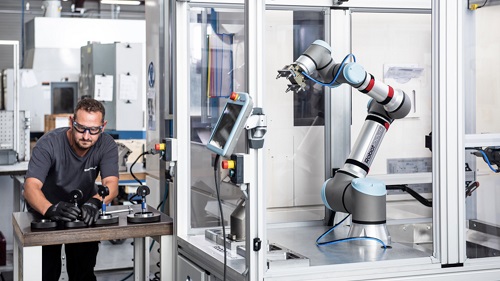Dave Hanslow, Sales Director at RNA Automation, has almost 40 years’ experience in robotics. Here he explains the key challenges facing manufacturers keen to minimise supply chain disruption by embracing these developing technologies.
A combination of Brexit and the covid pandemic has changed the face of UK manufacturing. The sudden departure of thousands of eastern European workers combined with social distancing and isolation of the infectious left many production lines desperately short of people power. This probably left some managers wishing they had embraced automation while the going was good.
On a normal assembly line people are often working almost shoulder to shoulder. Then in a flash the introduction of social distancing and the two-metre rule changed all that. A number of the companies that didn’t take the opportunity to automate had to shut down, as they had falsely believed there was no need to invest thousands of pounds in automation when there was a constant pool of labour to call on.
Robots on the march
 Businesses are having to learn to live with a new reality and at RNA Automation we have seen a huge spike in enquiries for robotics. How complex is it to programme robots for an assembly line? It’s quite challenging for robots to emulate some very dextrous applications that human senses can pick up on, like hearing something clicking together.
Businesses are having to learn to live with a new reality and at RNA Automation we have seen a huge spike in enquiries for robotics. How complex is it to programme robots for an assembly line? It’s quite challenging for robots to emulate some very dextrous applications that human senses can pick up on, like hearing something clicking together.
We went into a factory in the aerospace industry recently where they wanted to see what tasks could be automated. One process involved very complex metal machine parts for aeroplanes that needed filing and cleaning up to make sure there were no sharp edges. This was a skilled job that needed an operator’s eye to hand co-ordination which a robot couldn’t replicate.
However, robots can be adapted to automate manual processes common to many industries as well as interact with people. There are hospitals turning to cobots (collaborative robots) to help deliver medication and supplies to nurses, while officials in New York are trialling robot companions for elderly people to combat loneliness. Robots are built to suit a process and can be programmed to navigate safely around us.
Enquiries for any robot should not be based on quantity or cost but on specification. Whether you’re a major supplier in the aerospace sector or a growing small parts manufacturer it doesn’t mean always purchasing large expensive equipment – some robots are seen as an operator’s tool rather than a separate entity.
Big push for cobots
 Robots are normally looked at for mundane repetitive actions to free up staff for more complex and productive tasks, to lower a head count or to streamline and optimise production. Cobots are a good solution for automating fiddly time-consuming processes. They are easier to operate and cheaper than traditional, industrial robots making them the most popular option going forward.
Robots are normally looked at for mundane repetitive actions to free up staff for more complex and productive tasks, to lower a head count or to streamline and optimise production. Cobots are a good solution for automating fiddly time-consuming processes. They are easier to operate and cheaper than traditional, industrial robots making them the most popular option going forward.
But unlike many overseas manufacturers where human-robot collaboration has been widely accepted, in this country we still have major issues with a robot working in the same unguarded space as the operator, even though an automated operation taking over mundane tasks on the assembly line helps reduce repetitive strain injuries (RSI) among employees.
Cobots have the ability to work alongside people without a safety cage because they have built-in sensors that bring the machine to a halt if it touches an operator. But this type of incident could potentially be considered a collision injury under health and safety guidelines. The more expensive heavy duty six-axis industrial robot is guarded and isolated from staff but is less space friendly.
There has been a big push from companies trying to encourage cobots into their production lines because they think they are safer – and in certain applications they are. But you have to take into account the implications of operators working in parallel with partially automated lines and how best to ensure their safety without impacting productivity.
Prior to committing to delivery of an end solution, RNA carries out a proof of principle to develop and validate a working concept of the solution ahead of time, de-risking the project for both the machine builder and the end customer.
Learning curve for robotics
 Robots all require different levels of competence. Another advantage of a cobot is that it’s simpler to operate. An operator can be taught to programme the technology in less than an hour using a simplified robot teach pendant. That’s also why a lot of businesses are interested in cobots because they would save them having to pay for a specialist engineer to come out and programme an industrial robot.
Robots all require different levels of competence. Another advantage of a cobot is that it’s simpler to operate. An operator can be taught to programme the technology in less than an hour using a simplified robot teach pendant. That’s also why a lot of businesses are interested in cobots because they would save them having to pay for a specialist engineer to come out and programme an industrial robot.
The competence level required is much higher for a six-axis robot. Housed inside a cage it can perform a wider variety of applications. Therefore, a skilled engineer will probably take a week’s training course to learn the basics from scratch.
Ultimately, customers will bring their own vision to the table. A good systems integrator will have the expertise to be able to map out a journey of how robots can be deployed in the context of the customer’s factory operation, while remaining sympathetic to the immediate and longer-term objectives the customer is striving to achieve. Find an automation partner, like RNA Automation, that can help you take advantage of the opportunities the industry is going to bring, not just tomorrow but well into the future.
For more information visit our robotic system page.
END
Background
RNA Automation Ltd is a leading supplier of specialised automation engineering solutions. The company provides bespoke systems for advanced manufacturing industries including cosmetics, pharmaceutical, medical devices, electronics, plastics, metal working, food, consumer goods and automotive.
From its modern factory situated in the West Midlands RNA is capable of solving automation requirements in combination with its mission of quality, reliable service and back up. RNA has been established in the UK since 1986 and is renowned for an extensive product range and innovation.
With around 2000 systems supplied annually, RNA has a wealth of experience to draw upon. It can supply bespoke automated systems, feeding and handling, rotary indexing machines, inspection and vision systems and robotics.